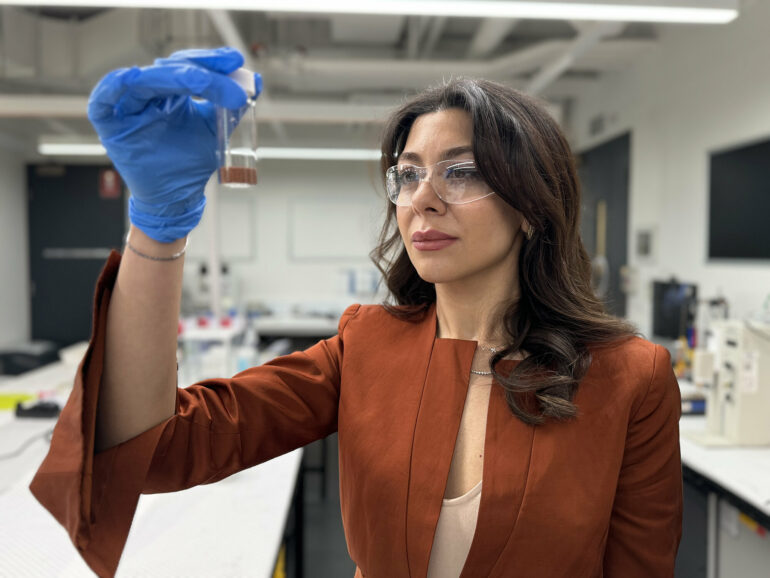A new way of making ammonia, by harnessing the unique power of liquid metal, could lead to significant cuts in carbon emissions caused by production of the widely-used chemical.
Ammonia is used in fertilizer to grow much of our food, but also plays a role in clean energy as a carrier to safely transport hydrogen.
The global production of ammonia, however, comes at a high environmental cost: It consumes over 2% of global energy and produces up to 2% of global carbon emissions.
RMIT Research Fellow and lead author of a study on this topic, Dr. Karma Zuraiqi, said her team’s greener alternative used 20% less heat and 98% less pressure than the century-old Haber-Bosch process used today for splitting nitrogen and hydrogen into ammonia.
The work appears in Nature Catalysis .
“Ammonia production worldwide is currently responsible for twice the emissions of Australia. If we can improve this process and make it less energy intensive, we can make a large dent in carbon emissions,” said Zuraiqi, from the RMIT School of Engineering.
Results of the study show the low-energy approach to be as effective at producing ammonia as the current gold standard by relying more on effective liquid metal catalysts and less on the force of pressure.
“The copper and gallium we use is also much cheaper and more abundant than the precious metal ruthenium used as a catalyst in current approaches,” Zuraiqi said. “These advantages all make it an exciting new development that we’re keen to take further and test outside the lab.”
Liquid metal to the rescue
The team including RMIT’s Professor Torben Daeneke is at the forefront of harnessing the special properties of liquid metal catalysts for ammonia production, carbon capture and energy production.
A catalyst is a substance that makes chemical reactions occur faster and more easily without itself being consumed.
This latest study showcased their new technique by creating tiny liquid metal droplets containing copper and gallium—named “nano planets” for their hard crust, liquid outer core and solid inner core structure—as the catalyst to break apart the raw ingredients of nitrogen and hydrogen.
“Liquid metals allow us to move the chemical elements around in a more dynamic way that gets everything to the interface and enables more efficient reactions, ideal for catalysis,” Daeneke said. “Copper and gallium separately had both been discounted as famously bad catalysts for ammonia production, yet together they do the job extremely well.”
Tests revealed gallium broke apart the nitrogen, while the presence of copper helped the splitting of hydrogen, combining to work as effectively as current approaches at a fraction of the cost.
“We essentially found a way to take advantage of the synergy between the two metals, lifting their individual activity,” Daeneke said.
RMIT is now leading the commercialization of the technology, which is co-owned by RMIT and QUT.
Upscaling for industry
While ammonia produced via the traditional Haber-Bosch process is only viable at huge facilities, the team’s alternative approach could suit both large-scale and smaller, decentralized production, where small amounts are made cheaply at solar farms, which in turn would slash transport costs and emissions.
As well as obvious applications in producing ammonia for fertilizer, the technology could be a key enabler for the hydrogen industry and support the move away from fossil fuels.
“One good way to make hydrogen safer and easier to transport is to turn it into ammonia,” Daeneke explained. “But if we use ammonia produced through current techniques as a hydrogen carrier, then emissions from the hydrogen industry could significantly increase global emissions. Our vision is to combine our green ammonia production technology with hydrogen technologies, allowing green energy to be shipped safely around the world without huge losses on the way,” he said.
The next challenges are to upscale the technology—which has so far been proven in lab conditions—and to design the system to operate at even lower pressures, making it more practical as a decentralized tool for a broader range of industries.
“At this stage, we are really excited by the results and are keen to speak with potential partners interested in scaling this up for their industry,” he said.
More information:
Unveiling metal mobility in a liquid Cu–Ga catalyst for ammonia synthesis, Nature Catalysis (2024). DOI: 10.1038/s41929-024-01219-z
Citation:
Low-carbon ammonia offers green alternative for agriculture and hydrogen transport (2024, September 19)



